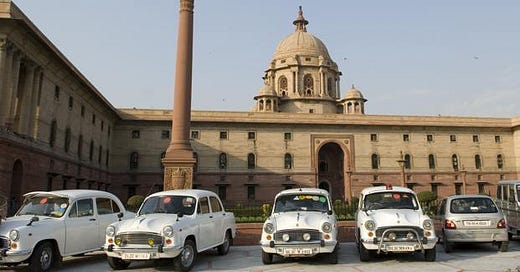Babu-mukt Bharat: Government of India Ministries sans IAS Officers
End of the IAS dominance in Central Ministries?
End of the IAS dominance in Central Ministries?
Earlier this week, the Central Government announced the names of nine private sector professionals who had been selected to be appointed as Joint Secretaries in various Departments/ Ministries, under what has popularly been described as the “Lateral Entry” Scheme. These had been selected from amongst 6077 applicants who had applied for by the July-end deadline of last year. The Economic Times reacted with a news item[1] on 13th April, 2019, spicily captioned as “Babu-mukt Bharat”.
It was argued that this was just the beginning of a reform process with far-reaching implications and apart from loosening the near monopoly stranglehold of the career civil servants on the crucial posts in the Central Government Ministries, could perhaps also be the beginning of the end of IAS-Babudom as well know it. In May-June last year, when this initiative had been announced, tremors had radiated across of the rank and file of not only the IAS but also other services that were beginning to claim an increasing share in the Additional- and Joint Secretary level posts at the centre.
“Lateral Entry” is no threat to the IAS
I had then published an article[2] on 12th June, 2018 arguing that “it is not lateral recruitment but ‘back-door entry’ of retired ‘babus’ that can cause real damage to the IAS.” The thrust of the argument was that the IAS is here to stay because it suits the political executive and minor tinkering with the system shall not lead to the dismantling of the steel-frame. While I essentially stick to my views expressed therein, it is perhaps time to examine whether an IAS-free[3] bureaucracy is possible at the national level and also try and envision the type of stresses it shall generate in the system of governance and policy-making of the Central Government. As a caveat, may I clarify in advance that I am not advocating that this scenario would be more efficient or effective, but just penning its likely implications, if this reform is pushed through as an ideological-cum-policy initiative from the very top.
IAS is not necessarily Cat’s Whisker
I would, however, before I venture further, leave the reader to peruse two of articles that I published in 2018 on this subject. The first one argues that with the increasing resource crunch and stress on the IAS, the service is now devoting disproportionate time and resources to VVIP clients[4]. This created quite a furore amongst serving as well as retired civil servants. The second one[5] essentially encapsulated the response of the IAS as a service, claiming to be “Specialists in Generalism”, in response to the increasing demand for subject specialists in the corridors of power.
Replacing IAS with professionals on contract
With this rather comprehensive backdrop, let’s fast-forward to a scenario where bulk of the Joint Secretaries as well as Additional Secretaries, and eventually even the Secretaries, in the Ministries of the Government of India comprise “specialist” selected from top-notch professionals from the private as well as public sector, serving on fixed-tenure, contractual basis. It would seem that these “civil service professionals” would be free from any historical baggage of their cadre and seniority/ batch and deal with the issues in a a purely objective and professional manner, free from the prejudices that jaundice the views of IAS officers. However, we need to delve a little deeper lest we reach an almost naïve conclusion that this new setup is really the utopian solution that this country always needed.
Telescopic view of the specialists
As we are well aware, policy as well as complex administrative issues cut across multiple sectors that require multi-, inter- and even intra-disciplinary approaches to arrive at optimal solutions. While each “subject-specialist” would try and maximize the parameters that he regards as essential and overriding from his telescopic perspective, the other stakeholders shall feel cheated or short-changed. In short, the proposed policies would not be acceptable to the other clients or would be so impractical that these would meet considerable resistance that the implementation level, even if these are got approved with political clout.
Disconnect from the grassroots scenario
Moreover, these “civil service professionals” would barely have any clue regarding the scenario at the grassroots level, which these policies would surely impact and also be implemented in. They, being totally devoid of the experience and insights gained by the IAS officers on account of their rich and varied flied experience, would not be able to fully visualize the conditions and constraints at the cutting-edge level, leaving them to bemoan their failed policies as being “superb that were sabotaged by poor implementation”.
Resolving conflicting demands
The “new civil service” would be totally lacking in the cadre and batch networks that are often used to expedite as well as resolve critical issues by the IAS officers. Even in the inter-ministerial discussions, the pecking order of seniority would be conspicuous by its absence and cantankerous difference of opinion would frequently crop-up, that would not be resolvable at the bureaucratic level. That would send up more issues to the political executive to sort out, depriving it of its valuable time which ought to be devoted to other priority areas.
Conclusion
In summary, it is not too difficult to visualize and propose a “Babu-mukt” Bharat within the Government of India but if this so-called reform is adopted and implemented thoughtlessly, as a pre-conceived attempt to completely ease out the IAS from its Delhi perch, it could very well create more problems than it actually solves. It may well be like, as the idiom goes, “throwing the baby with the bathwater”.
______________________________________________________________
KBS Sidhu. The Author is an IAS officer of 1984 Batch of Punjab cadre. The views expressed are his own.
He can be reached on kbs.sidhu@gmail.com or @kbssidhu1961 or https://www.facebook.com/kbs.sidhu
[1] https://economictimes.indiatimes.com/news/et-explains/babu-mukt-bharat-9-names-will-test-one-of-narendra-modis-biggest-reform/articleshow/68862140.cms
[2] https://theprint.in/opinion/ias-is-here-to-stay-because-it-suits-the-political-executive/69442/
[3] The term IAS has been used in the widest connotation here, to include other All India- and Central Sevices.
[4] https://theprint.in/opinion/ias-has-now-become-a-customer-service-pleasing-politicians-and-businessmen/111677/
[5] https://medium.com/@kbssidhu1961/ias-the-specialists-in-generalism-d09c64afd366






